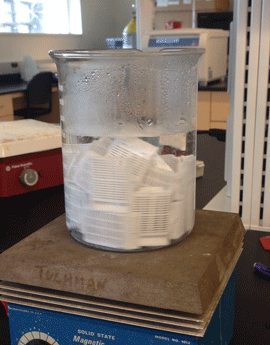a Tutorial by Sarah A-J
So, you have just collected your samples, good job! Now, the lab work. First you will want to sieve and grind your samples. You probably will want a total of around 3-5mL of sieved, dry, ground soil to work with. Depending on how rocky your soil is, you might have to sieve more or less soil. For me, to get around 5mL, I had to start with around 20mL of soil. I used a 2mm sieve.
After sieving I proceeded to dry my samples at 65 degrees Celcius for 2 days.
Post drying, I ground my samples twice using a mortar and pestle. Twice because I was unhappy with how fine the sample was after the first grinding. Because the final sample size that I will use in the Flash CN analyzer is only about 5-15mg, I think the sample has to be very fine and homogenized.
From upper right to lower left, you can really see the difference between unsieved, sieved, ground once, and ground twice.
Once your soil is all ready, you have to prepare them to drop into the Flash analyzer. Make sure you have all the nessicary equipment and stuff before you begin. Also, it's most time efficient if you plan to prep a large batch at a time. Don't prep the samples and then store them for a few days. Try to prep them and then put them in the analyzer soon after.
You will need tin sheets or pre-made tins, two tweezers, ethanol (for cleaning), a scupula, a high precision balance (preferably to 6 decimal places).















